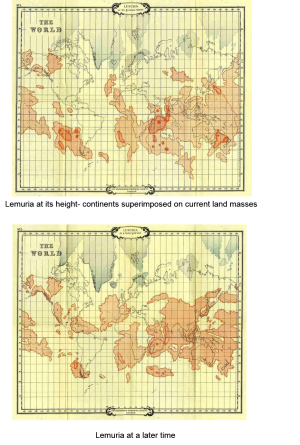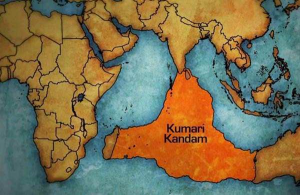Lemuria
Lemuria was a human civilization that existed about thirty-four million years ago. It was the home of the Third Root Race of humanity where great changes took place in human beings, both in their bodies and in their minds. Lemuria's main continent was south of what is now Asia in the Pacific Ocean on land masses long submerged due to powerful volcanic activity that eventually destroyed and submerged the civilization. Some of the lands that were part of Lemuria do still exist, like parts of the western United States, Australia, New Zealand, Madagascar, parts of Somaliland, the south of Africa, and the extreme southern portion of Patagonia. Existing thirty-four million years ago places Lemuria in the Jurassic period, meaning the Lemurians coexisted with the dinosaurs at least during part of the life of this world. It also means that the Lemurian civilization lasted about thirty million years and predated Atlantis.
Many people have heard of Atlantis if only in fables or science fiction but Lemuria, or Mu as it is sometimes called, is for the most part unheard of, yet it was on Lemuria during the development of the Third Root Race that the human body first took solid form. The First and Second Root Races, the Polarian and the Hyperborean, had ethereal rather than physical bodies. During the Third Root Race the earth had not yet hardened into solid form so it was softer and more malleable. Human bodies, too, were soft and malleable at first and nothing slightly resembling what we are today. It was also in Lemuria that the body divided into male and female beings and sexual reproduction began.
The importance of Lemuria in the human story cannot be overemphasized yet we have less detail about it than we do about Atlantis. We must rely on Theosophists like Mme. Blavatsky, Rudolph Steiner and William Scott-Elliot for answers. Physical proof pointing to the existence of an ancient landmass in the Pacific Ocean can be found but for the fascinating details of this awe-inspiring civilization we must turn to those who can read the Akaskic Records, or as Rudolph Steiner puts it, the Akasha Chronicle, and to the Masters who spoke in the Mahatma Letters.
In 1858 a young zoologist by the name of Philip Lutley Sclater playing around with an idea and struck on the possibility of a lost continent. This led to one of the longest running and weirdest theories that Lemuria was a lost island of lemurs. The name for the lost continent stuck.
Lemurian Life
The atmosphere the Lemurians live in was very different from what we know today. The air was thicker and the water was thinner. Large fern-like trees, similar to our palm trees, and great pine forests grew in the warm, wet climate. Amphibians, birds and lower mammals roamed the earth. At some point in Lemurian history man also lived with larger lizards which may have been remnants of the dinosaurs. If the dinosaurs lived during the early Lemurian times they probably found the bodies of early Lemurians not quite physically formed and later those bodies would have been gelatinous and probably would not have made a satisfying lunch for a huge predator.
When he first materialized into solid form man was a soft, non-boney mass. In this pliable form he was genderless yet he could reproduce without fertilization from another. His progeny was produced by a sort of egg that was “sweated” out. The offspring was a smaller replica of parent which grew to adult size but required tending by his parent entity. The organs of the small one were not fully developed outside the parent’s body and required heat to properly grow.
The large gelatinous body began to solidify and a soft bony structure developed. Early man could stand upright and had two eyes in the front of his head and a third eye in the back of back of his head. The third eye remained an organ of vision until the end of the Lemurian period. After that the third eye became an internal organ of psychic ability which continued into the Atlantian epoch. Today it is the pineal gland.
The following is a description of probably the fifth sub-race of Lemurians. "His stature was gigantic, somewhere between twelve and fifteen feet. His skin was very dark, being of a yellowish brown color. He had a long lower jaw, a strangely flattened face, eyes small but piercing and set curiously far apart, so that he could see sideways as well as in front, while the eye at the back of the head— on which part of the head no hair, of course, grew— enabled him to see in that direction also. He had no forehead, but there seemed to be a roll of flesh where it should have been. The head sloped backwards and upwards in a rather curious way. The arms and legs (especially the former) were longer in proportion than ours, and could not be perfectly straightened either at elbows or knees; the hands and feet were enormous, and the heels projected backwards in an ungainly way. Round his head, on which the hair was quite short, was twisted another piece of skin.”[1]
Division of the Sexes
Beginning in the middle stages of the Lemurian civilization the split of the sexes took place and proceeded very gradually. Long before individuals were born either male or female they carried the characteristics of both genders with one gender being more prominent and at this time self-impregnation was still possible. Slowly people began to be born either one gender or the other even as dual-gendered people were still being born. Around sixteen and a half million years ago humans began to reproduce as they do now.
Prior to the gender split man did not think; he had no brain yet so he had no organ for thought. He operated on impulses. His consciousness was dreamlike and dull. He was more animal than human. But also living among him were entities which Rudolf Steiner refers to as “superhumans.” These higher entities acquired knowledge and wisdom from clairvoyance. It was their task to impress upon man their own character which was love. Some superior beings incarnated in human form while others lived alongside and influenced humans through emanation.
When the genders were split half the person’s energy which was previously needed for single person reproduction was now available for other creations. The same force man used to impregnate himself was now directed inward to develop a brain. With the development of a brain finally, spirit, the faculty of thought, had an organ for exercising its function. Humanity was now enlivened with spirit.
Not all bodies developed at the same rate. Here is an interesting note about the apes. According to Mme. Blavatsky humanity has had the assistance of higher beings to further our evolution. At this time we had several classes to assist us. One class of these are called the Dhyanis or Sons of Wisdom, who were destined to incarnate in human beings for the purposes of leadership. Some of the Dhyanis delayed incarnating. By this time some of the underdeveloped protohumans had bred with an extinct ape-like species and produced a hybrid race. The late-comer Dhyanis had to incarnate into these human-animals. These bodies were not properly developed to house the superior beings. The descendant of this race are the apes; they failed to develop further and, in fact, degenerated. “Thus the apes are men of a past epoch who have regressed. As man was once less perfect than he is at present, they were once more perfect than they are now.”[2] This explains the striking similarities between men and apes but destroys Darwin’s idea of evolution.
The Lemurian Root Race, like all Root Races, consisted of seven sub-races which are not specifically named. And just as all Root Races have an overriding theme for development, for the Lemurians the focus was the will and the development of imagination. Once the Lemurians had separated into male and female the work of their race began in earnest with education of the children.
There was no memory and thus no language but Lemurians did have ideas which they could not hold for long. But their ideas had a power for them and for others who could read those thoughts and that was their communication.
The boys and girls were educated separately. Boys were “hardened”. They were made to learn to endure the pain and suffering of torture, accomplish dangerous feats and “the bearing of heat, even of a searing fire, the piercing of the body with pointed objects, were quite common procedures.”[3] Boys who could not endure were not considered useful members of society and were left to die in their efforts.
Girls were also hardened but it was nothing like what boys had to go through. Girls were hardened by being exposed to a dreadful storm and expected to remain calm. She had to witness the boys in combat and had to do so fearlessly and come to admire the strength and power she saw. This was intended to cultivate the imagination but having no memory she was dependent on outside stimulation to create the imagination over and over again.
Women developed special human powers. “Their faculty of imagination which was in alliance with nature, became the basis for a higher development of the life of ideas. They took the forces of nature into themselves, where they had an after-effect in the soul. The germs of memory were formed. With memory was also born the capacity to form the first and simplest moral concepts.”[4] It was from women that the first idea of “good and evil” arose.
At first men knew nothing of this way of being. They followed instinctively either natural impulses or the influence of emanation from the initiated ones.
Women began to exercise a sort of judgment and came to love things that had a positive impression on imagination and abhor other things that did not impress the imagination favorable. From this the seeds of law and morals began. In her soul woman accessed a kind of spiritual power and clairvoyance unlike the will of men. She had memory.
When the superhuman beings who sorted out the beginnings of what would become the first Atlantian Race, they put women in charge of the smaller groups they were divided into. Through memory she could put the past to use. Through her understanding of good and evil she led with justice. “Through her thoughtful life she had acquired and understanding of nature, those ideas developed in her according to which she directed the actions of men. The leaders had arranged things in such a way that through the soul of woman, the willful nature of men was ennobled and refined.”[5]
Through the awakened soul life of women, the leaders also awakened it in men. Women took this even further connecting with the powers of spirit. “Everything was animated for them and showed itself to them in soul powers and apparitions. They abandoned themselves to the mysterious weaving of the soul forces. That which impelled them to their actions were “inner voices……”[6] In dreams the secrets of nature were divulged to them.
Others began to gather round her to listen to her song, the beginning of language being song-like. They listened eagerly to the utterances of these “wise-woman”, “the priestess.” Here is the beginning of religion. One can also see a matriarchy in action. And it is easy to imagine the Oracle of Delphi singing her strange unintelligible song to an enthralled audience millions of years later.
The End of Lemuria
In the beginning, the Lemurians lived where ever nature provided, in caves, for example. Later as the civilization progressed they began to purposefully build structures to live in, in areas where the volcanic activity was less. The volcanic activity was so widespread throughout Lemuria the people could not settle for long in one place without new eruptions causing them to move on. It was this constant volcanic activity that finally tore the world apart and sunk Lemuria.
Some Lemurians did escape the destruction and migrated. They left descendants in Capoid race, the Congoid race, the Dravidians, and the Australoid race. Other Lemurians were deliberately relocated to specific area to prepare to seed the next race of Atlantians. The end of the Lemurian civilization marked the end of phenomenal development for mankind both by achieving physical existence and then splitting the individual into two genders.
The Tamil people of southern India are descendants of the Dravidians race. In their culture they have a legend of a sunken continent called Kamari Kandam which they say was the cradle of civilization. It was located just south of India in the Indian Ocean precisely were part of Lemuria is said to have been.
Early man had a great deal of help in his development from higher entities, both in physical and non-physical form. In the Third Race long before speech Lemurians were directed telepathically by superior beings in all aspects of their everyday life. Atlanteans too enjoyed a close direct link with beings of great intelligence murmuring in their ears but the experience of the Fifth Race has not been like that of our predecessors. The higher beings are still with us but they do not direct us anymore or as Julian Jaynes lamented the gods stopped talking to us.
Being denied such communication may seem as though we are unworthy or that we are not spiritual enough or perhaps we are not meditating properly but Rudolph Steiner has another explanation. We in the Fifth Race are developing thought and with thought comes judgment. We have the freedom to think for ourselves and make decisions for ourselves. We have freedom Lemurians and Atlanteans could never have dreamed of. We can excel or degenerate.
Bibliography and Further Reading
Blavatsky, H.P. The Secret Doctrine II – Anthropogenesis, Theosophical University Press, Pasadena, California, 1970 (1888).
Elliot, William S. The Story of Atlantis & the Lost Lemuria, Etc. (reprinted.). London: Theosophical Publishing House, 1954. Print.
Godwin, Joscelyn. Atlantis and the Cycles of Time: Prophecies, Traditions, and Occult Revelations. Rochester, VT: Inner Traditions, 2011. Print.
Steiner, Rudolf. Cosmic Memory: Prehistory of Earth and Man. Englewood, N.J: Rudolf Steiner Publications, 1959. Print.
https://en.wikipedia.org/wiki/Root_race
- ↑ Elliot, William S. The Story of Atlantis & the Lost Lemuria, Etc. (reprinted.). London: Theosophical Publishing House, 1954. Print. P. 112-113
- ↑ Steiner, Rudolf. Cosmic Memory: Prehistory of Earth and Man. Englewood, N.J: Rudolf Steiner Publications, 1959. Print. P. P110
- ↑ Steiner, Rudolf. Cosmic Memory: Prehistory of Earth and Man. Englewood, N.J: Rudolf Steiner Publications, 1959. Print. P.73
- ↑ Steiner, Rudolf. Cosmic Memory: Prehistory of Earth and Man. Englewood, N.J: Rudolf Steiner Publications, 1959. Print. P. 78
- ↑ Steiner, Rudolf. Cosmic Memory: Prehistory of Earth and Man. Englewood, N.J: Rudolf Steiner Publications, 1959. Print. P. 80
- ↑ Steiner, Rudolf. Cosmic Memory: Prehistory of Earth and Man. Englewood, N.J: Rudolf Steiner Publications, 1959. Print. P. 81


